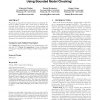Free Online Productivity Tools
i2Speak
i2Symbol
i2OCR
iTex2Img
iWeb2Print
iWeb2Shot
i2Type
iPdf2Split
iPdf2Merge
i2Bopomofo
i2Arabic
i2Style
i2Image
i2PDF
iLatex2Rtf
Sci2ools
126
Voted
DAC
2003
ACM
2003
ACM
Behavioral consistency of C and verilog programs using bounded model checking
We present an algorithm that checks behavioral consistency between an ANSI-C program and a circuit given in Verilog using Bounded Model Checking. Both the circuit and the program are unwound and translated into a formula that represents behavioral consistency. The formula is then checked using a SAT solver. We are able to translate C programs that include side effects, pointers, dynamic memory allocation, and loops with conditions that cannot be evaluated statically. We describe experimental results on various reactive circuits and programs, including a small processor given in Verilog and its Instruction Set Architecture given in ANSI-C. Categories and Subject Descriptors B.5.2 [Hardware]: Register-Transfer-Level Implementation--Design Aids; F.3.1 [Theory of Computation]: Logics and Meanings of Programs--Specifying and Verifying and Reasoning about Programs General Terms Verification Keywords Verilog, ANSI-C, Equivalence Checking ?This research was sponsored by the Semiconductor Rese...
Behavioral Consistency | DAC 2003 | Design Automation | Motors Collaborative Research | Naval Research Laboratory |
Related Content
| Added | 13 Nov 2009 |
| Updated | 13 Nov 2009 |
| Type | Conference |
| Year | 2003 |
| Where | DAC |
| Authors | Edmund M. Clarke, Daniel Kroening, Karen Yorav |
Comments (0)

